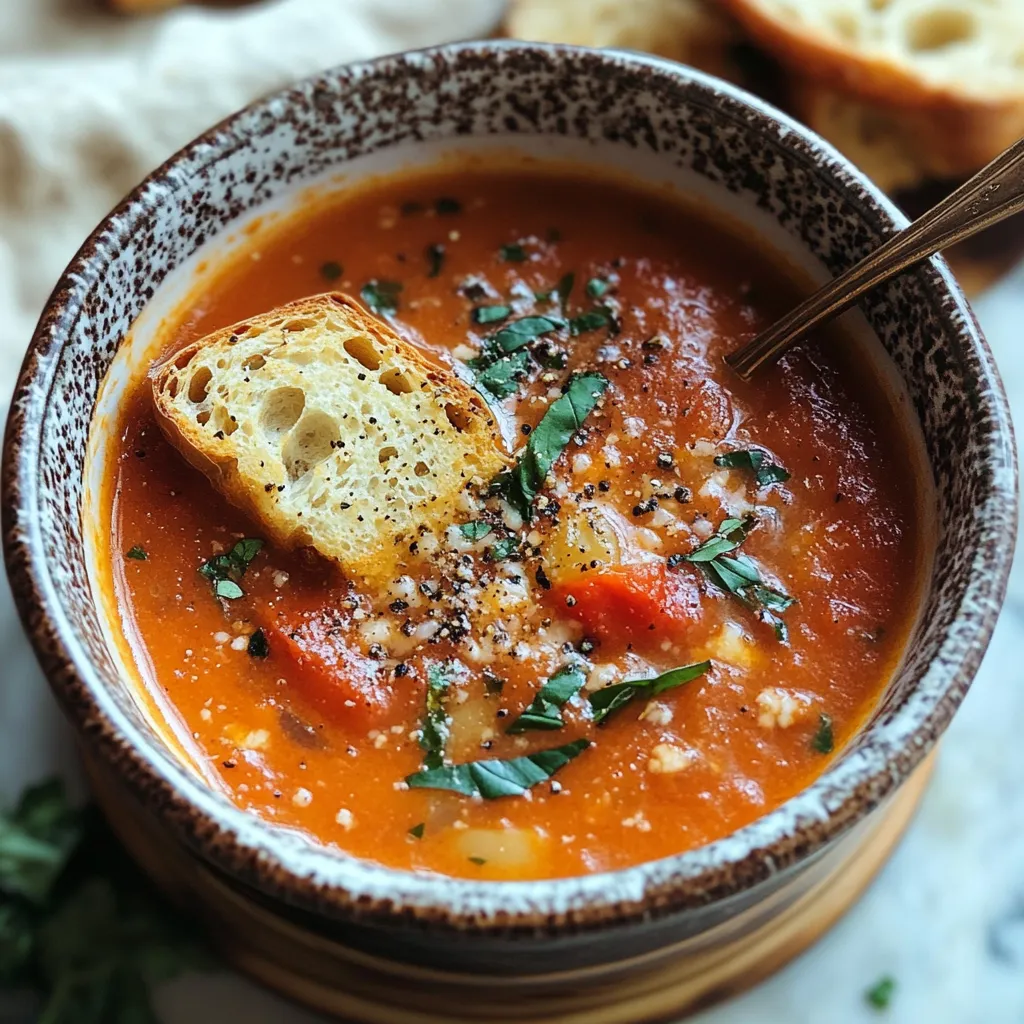 Pin
Pin
This Italian tomato and bread soup, known as Pappa al Pomodoro in Tuscany, transforms humble ingredients into a comforting bowl that warms both body and soul. The rustic combination of bread soaked in tomato broth creates a velvety texture that feels like a warm embrace on a chilly evening.
I first encountered this soup while traveling through Tuscany during harvest season. The elderly proprietress of a small farmhouse served it with such pride that I immediately understood this was more than just soup it was culinary heritage in a bowl.
Ingredients
- Olive oil: Quality matters tremendously here as it provides the foundation flavor
- Onion and garlic: Create the aromatic base that gives the soup depth
- Whole peeled tomatoes: Are ideal as they offer better flavor than diced varieties
- Vegetable broth: Enhances the savory notes but water works in a pinch
- Stale crusty bread: Specifically Italian or sourdough provides the perfect texture
- Fresh basil: Brings brightness and that distinctive Italian character
- Parmesan cheese: Adds a salty umami finish that elevates everything
Step-by-Step Instructions
- Sauté Aromatics:
- Take your time with this foundational step. Heat olive oil until it shimmers then add finely chopped onion. Cook slowly for a full 5 minutes until the onions turn translucent and begin to sweeten. Add minced garlic only in the final 30 seconds to prevent burning which would impart bitterness to your soup.
- Add Tomatoes and Simmer:
- If using whole tomatoes crush them by hand as you add them to the pot. This creates varied texture that makes the soup more interesting than using preprocessed crushed tomatoes. Add your broth salt pepper and red pepper flakes then allow everything to simmer together for 15 minutes which concentrates flavors and begins to build the soul of your soup.
- Incorporate Bread and Basil:
- Add torn bread pieces and fresh basil then continue simmering for another 15 minutes. The bread will gradually break down and thicken the soup creating that signature velvety texture. Stir occasionally to help the bread incorporate fully into the liquid.
- Adjust Texture:
- For a more traditional rustic version simply mash some of the bread chunks with a wooden spoon against the side of the pot. If you prefer a smoother consistency use an immersion blender with a light touch just a few pulses will create a silky texture while maintaining some character.
- Serve with Love:
- Ladle into warmed bowls and finish each portion with a generous drizzle of your best olive oil additional torn basil leaves and freshly grated Parmesan. The final olive oil is not optional it creates heavenly aromatic pools on the surface that transform each spoonful.
My grandmother taught me that the soul of this dish comes from patience. She would always say "good Pappa al Pomodoro needs time to rest like a good conversation." I still remember the way she would tear the bread with her hands saying machines could never understand the proper size.
Make It Your Own
The beauty of this traditional soup lies in its adaptability. While purists might insist on specific ingredients there are numerous ways to personalize this recipe according to your taste and what you have available. Some regions add carrots or celery to the aromatic base while others might include a splash of wine during the simmering process. Experiment with adding a Parmesan rind during cooking for extra depth or try different herbs like oregano or thyme alongside the basil.
Storage and Reheating
This soup famously improves overnight as the flavors continue to develop and meld. Store leftovers in an airtight container in the refrigerator for up to three days. When reheating add a small amount of water or broth as the bread continues to absorb liquid. Warm slowly over medium low heat stirring occasionally to prevent sticking. Finish with fresh olive oil and herbs before serving to revive the bright flavors.
The Cultural Significance
Pappa al Pomodoro represents the heart of Tuscan cucina povera "poor cooking" that transformed necessity into culinary art. During harder times when nothing could be wasted this soup became a clever way to use stale bread and summer tomato harvests. The dish varies from household to household with each family claiming their version as the definitive recipe. In many homes this soup signals the peak of summer when tomatoes are at their sweetest and most abundant.
Seasonal Variations
Summer brings the opportunity to make this soup with fresh ripe tomatoes straight from the garden. Simply blanch peel and deseed them before using. In winter high quality canned tomatoes provide consistent flavor. Spring might see the addition of young garlic or early basil while autumn versions sometimes incorporate a small amount of roasted pepper or the last tomatoes of the season. Each season brings its own character to this timeless recipe.
Recipe Questions & Answers
- → What type of bread is best for this soup?
Crusty, stale bread such as Italian or sourdough works best. Remove tough crusts for a smoother texture.
- → Can I use fresh tomatoes instead of canned?
Yes, fresh ripe tomatoes are a great substitute. Peel and cook them down longer to match the consistency of canned tomatoes.
- → How can I adjust the soup's texture?
For a smoother texture, use an immersion blender to lightly puree the soup. For a chunkier feel, mash it with a spoon.
- → What toppings go well with this soup?
Drizzle good olive oil, sprinkle grated Parmesan, and add fresh basil leaves for extra flavor and presentation.
- → Can I prepare this soup ahead of time?
Yes, the soup tastes even better the next day as the flavors meld. Reheat gently on the stovetop before serving.